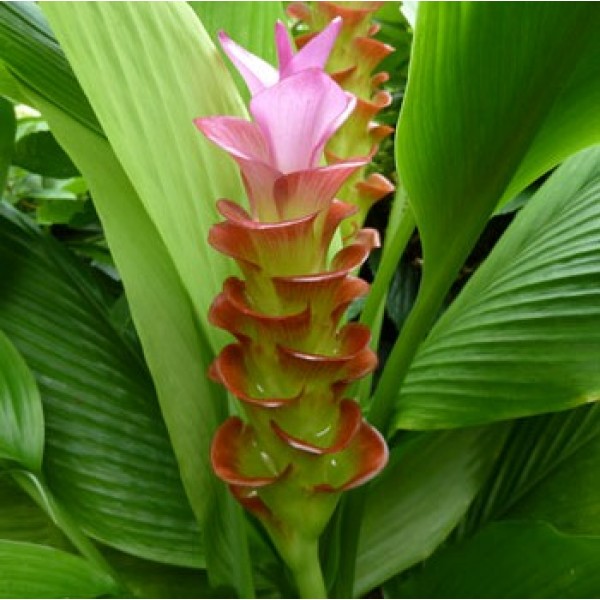This image is for reference purpose only, Photo May Slightly Different From Actual Item in Terms of Color Due to the Lighting During Photo Shooting or the Monitor's Display.
Haldi - Turmeric
Turmeric (Curcuma longa) /ˈtɜrmərɪk/ is a rhizomatous herbaceous perennial plant of the ginger family, Zingiberaceae. It is native in southeast India, and needs temperatures between 20 °C and 30 °C (68 °F and 86 °F) and a considerable amount of annual rainfall to thrive. Plants are gathered annually for their rhizomes, and propagated from some of those rhizomes in the following season.
When not used fresh, the rhizomes are boiled for about 30–45 minutes and then dried in hot ovens, after which they are ground into a deep orange-yellow powder commonly used as a spice in Indian cuisine and even curries, for dyeing, and to impart color to mustard condiments. One active ingredient in it is curcumin. It has a distinctly earthy, slightly bitter, slightly hot peppery flavor and a mustardy smell. Curcumin may treat: cancer, Alzheimer's disease, diabetes, allergies, arthritis and other chronic illnesses.
Uses
Turmeric powder is used extensively in South Asian cuisine. Turmeric grows wild in the forests of South and Southeast Asia. It is one of the key ingredients in many Asian dishes. Tamil traditional medicine, called Siddha, has recommended turmeric for medicine. Its use as a coloring agent is not of primary value in South Asian cuisine.
Turmeric is mostly used in savory dishes, but is used in some sweet dishes, such as the cake Sfouf. In India, turmeric plant leaf is used to prepare special sweet dishes, patoleo, by layering rice flour and coconut-jaggery mixture on the leaf, and then closing and steaming it in a special copper steamer (goa).
In recipes outside South Asia, turmeric is sometimes used as an agent to impart a rich, custard-like yellow color. It is used in canned beverages and baked products, dairy products, ice cream, yogurt, yellow cakes, orange juice, biscuits, popcorn color,cereals, sauces, gelatins, etc. It is a significant ingredient in most commercial curry powders.
Most turmeric that is used is in the form of rhizome powder, in some regions (especially in Maharashtra, Goa, Konkan and Kanara), turmeric leaves are used to wrap and cook food. This use of turmeric leaves usually takes place in areas where turmeric is grown locally, since the leaves used are freshly picked. Turmeric leaves impart a distinctive flavor.
Although typically used in its dried, powdered form, turmeric is also used fresh, like ginger. It has numerous uses in Far Eastern recipes, such as pickle made from fresh turmeric that contains large chunks of soft turmeric.
Turmeric is widely used as a spice in South Asian and Middle Eastern cooking. Many Persian dishes use turmeric as a starter ingredient. Almost all Iranian fried dishes consist of oil, onions, and turmeric followed by any other ingredients that are to be included.
In Nepal, turmeric is widely grown and extensively used in many vegetable and meat dishes for its color as well as for its potential value in traditional medicine.
In South Africa, turmeric is used to give boiled white rice a golden color.
In Vietnam, turmeric powder is used to color, and enhance the flavors of, certain dishes, such as bánh xèo, bánh khọt and mi quang. The powder is also used in many other Vietnamese stir fried and soup dishes.
In Indonesia, the turmeric leaves are used for Minangese or Padangese curry base of Sumatra, such as rendang, sate padang and many other varieties.
In Thailand, fresh turmeric rhizomes are widely used in many dishes, in particular in the southern Thai cuisine, such as the yellow curry (แกงเหลือง)and turmeric soup (ต้มขมิ้น).
In medieval Europe, turmeric became known as Indian saffron because it was widely used as an alternative to the far more expensive saffron spice.
Folk medicine and traditional uses
In Tamil Nadu, turmeric has been used traditionally for thousands of years as a remedy for stomach and liver ailments, as well as topically to heal sores, basically for its supposed antimicrobial property. In the Siddha system (since c. 1900 BCE) turmeric was a medicine for a range of diseases and conditions, including those of the skin, pulmonary, and gastrointestinal systems, aches, pains, wounds, sprains, and liver disorders. A fresh juice is commonly used in many skin conditions, including eczema, chicken pox, shingles, allergy, and scabies.
Manjal Pal (turmeric milk) is warm milk mixed with some turmeric powder. It is commonly used in Tamil Nadu as a home remedy when someone is suffering from fever. Turmeric paste is often used in Tamil Nadu as an antiseptic in open wounds, while chun-holud (turmeric with slaked lime) is used to stop bleeding as home remedies. It is also used as a detanning agent in Tamil Nadu.
The active compound curcumin is believed to have a wide range of biological effects including anti-inflammatory, antioxidant, antitumour, antibacterial, and antiviral activities, which indicate potential in clinical medicine. In Chinese medicine, it is used for treatment of various infections and as an antiseptic.
Haldi - Turmeric Plant
- Live plant along with plastic pot
- plants height with pot is 1 feet and pot size is 5 icnhes diameter.
- plants nature is outdoor-semi shade, alternate day watering
- useful for edible Plants, herbs & medicinal plants
- Rare herb plants & medicinal plant
